Put the switch at the back, or, even better, switch off the SMPS at the main's plug, so the latter doesn't stay on for nothing either
Claude
Claude
I'm building a clone of the lottery Sony VFET amplifier. It draws just under 2 amperes per channel, and I've chosen to install my on/off power switch between the SMPS and the amp. This means the SMPS itself is always "on" and, according to its datasheet, dissipating 150 milliwatts. One sixth of a watt.
The switch I selected, to make and to break the connection between the 36V DC brick and the amplifier, is Mouser part number 633-JWL11BC2A-A. According to its datasheet here, it's rated for 72VDC (notice: DC ) telecom applications, at 5 amperes. Which seems like a comfortable margin of safety.
Hope this is useful info.
The switch I selected, to make and to break the connection between the 36V DC brick and the amplifier, is Mouser part number 633-JWL11BC2A-A. According to its datasheet here, it's rated for 72VDC (notice: DC ) telecom applications, at 5 amperes. Which seems like a comfortable margin of safety.
Hope this is useful info.
Hi Mark,
that switch looks interesting.
I think this is an interesting topic, as it seems that we will be using SMPS more often in the future, and therefore might in a lot of applications switch DC instead of AC, and then often several amps of DC.
Will you add some "arc quencher" to save the contacts at switch-off ? I don't know the exact english term for this in the low-voltage / moderate current realm, but in the old days we did use a capacitor or capacitor-resistor combination across the contacts.
When switching DC, there is considerable stress on the contacts actually rather when switching off ... and compared to switching AC, the arc can burn for longer.
Regards, Claas
that switch looks interesting.
I think this is an interesting topic, as it seems that we will be using SMPS more often in the future, and therefore might in a lot of applications switch DC instead of AC, and then often several amps of DC.
Will you add some "arc quencher" to save the contacts at switch-off ? I don't know the exact english term for this in the low-voltage / moderate current realm, but in the old days we did use a capacitor or capacitor-resistor combination across the contacts.
When switching DC, there is considerable stress on the contacts actually rather when switching off ... and compared to switching AC, the arc can burn for longer.
Regards, Claas
Hi, I might have a problem. I rewired the inputs, added a volume pot. Then connected the NuTube between dac and Pass ACA. Then wanted to connect the 24V power and got a spark between 24V plus and the NuTube ground. This before really connecting. Off course I did not connect. I don't see any false connections. When I measure the power input on the NuTube I get only 270 Ohm between plus and ground. Is that much to low or an result of the capacitors?
Maybe its normal to get a spark when accidentally touching 24V plus to ground? If I look closely I see black spots on both connectors.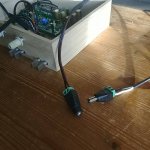
Maybe its normal to get a spark when accidentally touching 24V plus to ground? If I look closely I see black spots on both connectors.

Hi, I messure the (475 ohms). I bouth it as 470ohm ( did not assume it was that importent ). They messure 467ohm and 469ohm.
As NP say, 5ohm can make a difference. So, I will put in two Dale 475ohms ( messure 473.9ohm). Can also the ringing problem at start of testing the Nutube been fatige the nutube wire?
One time I got to bed with music on, next morning I hear a loud ringing ( 5000Hz ). It may have gone on for 2, 3, 4 hours.
Frank
As NP say, 5ohm can make a difference. So, I will put in two Dale 475ohms ( messure 473.9ohm). Can also the ringing problem at start of testing the Nutube been fatige the nutube wire?
One time I got to bed with music on, next morning I hear a loud ringing ( 5000Hz ). It may have gone on for 2, 3, 4 hours.
Frank
Hi, I might have a problem. I rewired the inputs, added a volume pot. Then connected the NuTube between dac and Pass ACA. Then wanted to connect the 24V power and got a spark between 24V plus and the NuTube ground. This before really connecting. Off course I did not connect. I don't see any false connections. When I measure the power input on the NuTube I get only 270 Ohm between plus and ground. Is that much to low or an result of the capacitors?
Maybe its normal to get a spark when accidentally touching 24V plus to ground? If I look closely I see black spots on both connectors.
No problem on my side. Just a power connector that easily makes contact between plus and ground while connecting. I'll change that one.
... add some "arc quencher" to save the contacts at switch-off ? I don't know the exact english term for this in the low-voltage / moderate current realm, but in the old days we did use a capacitor or capacitor-resistor combination across the contacts.
When switching DC, there is considerable stress on the contacts actually rather when switching off ... and compared to switching AC, the arc can burn for longer.
Switch-off is especially bad when the load is inductive, such as a motor, solenoid, or relay coil. I don't think the +36V DC power input to the DIY VFET amplifier acts very much like an inductance, so I don't expect much (L * di/dt) kickback voltage at switch-off . . . where, oh by the way, di/dt = -Infinity.
So, I have no plans to install an "arc suppressor" (common engineering name: "snubber") across the switch contacts. In my opinion, adding an arc suppressor certainly MIGHT help, perhaps only a tiny benefit, but it certainly cannot possibly hurt. That means the risk equals zero and the reward is nonzero, giving an excellent (reward / risk) ratio.
However, I'm not going to install one. I reckon the switch manufacturer has built the switch to handle even worst cases than mine. Its datasheet spec is switch-off with 5A @ 72VDC , my application is only 4A @ 36VDC. I've already paid big money for a DC rated switch (most switches are not DC rated), why pay more for a snubber.
If anyone is considering installing an arc suppressing snubber anyway, I think it would be worthwhile to study the Cornell Dubilier "Quencharc" line of products. Here's a datasheet. They are surprisingly expensive at Mouser and DigiKey 😱 . Maybe you'll prefer to buy a device from a competitor whose app notes and datasheets are less comprehensive than Cornell Dubilier's. You can find them in these places
DigiKey: Product Index ----> Filters ----> EMI/RFI Filters (LC, RC Networks)
Mouser: All Producte ----> Passive Components ----> Capacitors ----> Film ----> RC Snubbers
Hi, I started soldering the resistors. Now I have a small problem. The partslist mentions only two 100 Ohm resistors. So now I'm short on two nice 100 Ohm Dale resistors.
I do have a few spare resistors. I have 70 Ohm or I can make 110 Ohm from 2x 220 Ohm. What is advisable?
Thanks, Jaap
View attachment 952578
The Korg article at diyaudio store has never been updated to correct this error although the article at passdiy has been long fixed.
No problem. I got good advice and the NuTube is up and running [emoji41]The Korg article at diyaudio store has never been updated to correct this error although the article at passdiy has been long fixed.
The Korg article at diyaudio store has never been updated to correct this error although the article at passdiy has been long fixed.
Thanks for the note. It had been updated on the PCB + JFETs page here but not the full kit page. Now correct on both 🙂
Problem with both pots
I have trouble trimming T7 and T8 to 9.5 Volts.
Lowest value for T7 is 9.51 Volts, for T8 it is 9.75 Volts.
The sound is quite distorted.
My R1s are 220 Ohms.
T1 23.98
T2 23.11
T3 22.31
T4 8.81
T5 0.621
T6 0.637
All readouts after 1 hour warm up.
I have trouble trimming T7 and T8 to 9.5 Volts.
Lowest value for T7 is 9.51 Volts, for T8 it is 9.75 Volts.
The sound is quite distorted.
My R1s are 220 Ohms.
T1 23.98
T2 23.11
T3 22.31
T4 8.81
T5 0.621
T6 0.637
All readouts after 1 hour warm up.
Last edited:
I'm thinking of wiring the two 10K pots to 10K pots on the outside of the box. And also wiring T7, T8 and GND to a insulated connector on the outside of the box. That way I could easily connect a multimeter and adjust the plate voltages. Can I do this without risk of creating noises?
Reason is I'm planning mount the NuTube into my diy Purify power amp housing. It would be a hassle to move and open the power amp for plate voltage adjustments 🙂
Reason is I'm planning mount the NuTube into my diy Purify power amp housing. It would be a hassle to move and open the power amp for plate voltage adjustments 🙂
Last edited:
I have trouble trimming T7 and T8 to 9.5 Volts.
Lowest value for T7 is 9.51 Volts, for T8 it is 9.75 Volts.
The sound is quite distorted.
My R1s are 220 Ohms.
T1 23.98
T2 23.11
T3 22.31
T4 8.81
T5 0.621
T6 0.637
All readouts after 1 hour warm up.
Those voltages aren't off enough to cause the problem. What is the voltage across the 221 ohm resistors?
- Home
- Amplifiers
- Pass Labs
- B1 with Korg Triode
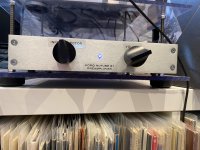
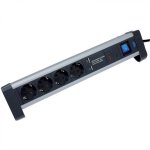
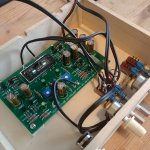
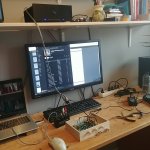
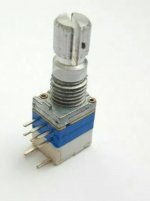
 Please
Please